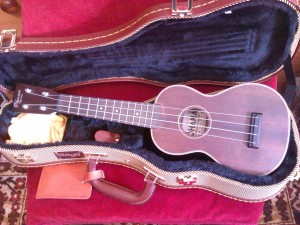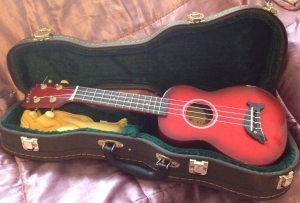Yes Sir, That’s My Baby
Everyone is playing ukuleles these days, it seems. YouTube has allowed people to share their progress and performances with ease and the Internet generally has given us all instant access to more lessons, songs and inspiration than we could ever possibly hope to use. The little instrument is back in favour on a scale not seen since the fifties, shortly before Rock ‘n’ Roll persuaded everyone that they should be playing a guitar instead.
When I was a wee lad I had a few – a very few – music lessons, including several on the acoustic guitar, but I never made the slightest progress and couldn’t find an instrument for which I felt the slightest warmth or aptitude. Well, the flute seemed promising. At school they would occasionally have people come in with different instruments to encourage us to learn, so I gave the flute a go and was told, rather devastatingly, that my lips were too big. They thought I might be better with the trombone… Okay, not quite the same thing, but I was prepared to give it a try:
“We don’t do trombones,” they said.
Years later I’d seen and heard ukuleles and quite liked them, the sound appealed to me and they had a certain cheerfulness and lack of pomposity I found endearing, but the uke was a toy, a joke… it was Tiny Tim rather than George Thorogood. The notion of wandering into a music shop (intimidating places at the best of times for the resolutely unmusical) and buying one was laughable. And then the wheel turned, ukes became popular again and people started making good ones in volume, easily available (via the Internet, for those still clinging to the embarrassment associated with displaying their musical ignorance in the shops); and The Lovely Emma bought me a ukulele for Christmas as I mentioned in an earlier post. Although she’s a trained and skilled violinist Em knew as little about ukuleles as I did at the time (perhaps less on the trivia side; certainly a little more as far as her knowledge of music and instruments extends), so she did a little research and in the end found a chap on eBay selling a package of ukulele with a simple case, electronic tuner and chord chart for a good price, branded as an “Hawaii Kai”. I was thrilled, particular when two things happened: firstly, I discovered that the instructions for the tuner were so poorly translated from Chinese that I’d been tuning the thing incorrectly for a week (although it was precisely, consistently incorrect); and secondly I started teasing recognisable tunes from the ukulele… actual music, haltingly played and with many fumbles and mistakes, but by George I was actually making swift progress! This is probably a major reason for the popularity of the ukulele, since virtually anyone can quickly reach a point where it’s clear that they’re getting better.
That eBay uke is made from a laminated wood, dyed to give a deep brown finish, and is fitted with guitar-style geared tuners rather than the friction pegs (much like the ones you’ll see on a violin) traditionally associated with soprano ukuleles. The seller changed the standard strings for a set of Aquila branded ones, which alone boosts the quality of sound dramatically. The result is a completely playable, excellent first instrument, more than adequate for testing the waters and finding out if I was really going to enjoy and continue playing it. Six months, one set of strings, several sore fingers and many hours of practice later I have no illusions that I’m actually any good when it comes to playing the ukulele, but I’m good enough to be enjoying it immensely and catching my first glimpses of what “real” musical types feel when they get lost in the simple delight of making music. I’m also at the stage where I can begin to tell the difference between a fault caused by my playing and one inherent to the particular instrument. The too-frequent “buzz” of the strings, the rough edges on the frets (cause of many a ripped and battered nail), a slight lack of volume and depth to the sound… it was time to think about stepping up to a slightly better instrument.
Compared to many other musical instruments, ukuleles are remarkably reasonably priced. A very good one indeed can be had for the cost of a pretty mediocre guitar, for instance. Taking into account my budget, level of ability (and the level I’m likely to achieve anytime soon) and the sort of music I most enjoy playing I narrowed the choices a little, with a couple of promising frontrunners: the Mainland Red Cedar Soprano and the Ohana SK-38. Clicking those links takes you to YouTube video overviews of the ukuleles; the Mainland video also conveniently discusses the Ohana SK-35, which was probably my third choice to try. The Lovely Emma and I drove out towards Huddersfield and the Eagle Music Shop, as far from the intimidating and unfriendly music stores I’d been into in the past as can be imagined. Seconds after walking in we were offered a cup of tea, so they won me over quite quickly. Eagle are apparently the only UK stockist for Mainland ukuleles, which made their relative proximity to us a stroke of luck. I’d contacted them a while ago asking whether they could get the Mainlands with some of the options offered on the company’s own website, such as friction tuners, and a few weeks later received an email letting me know that they had a red cedar soprano in stock with friction pegs. Unsurprisingly, it had sold by the time we were able to make a visit to the shop, but I knew they had similar models so I’d be able to play a few and get an idea of the sound. Unfortunately, according to their website Eagle didn’t carry the Ohana SK-38, but the SK-35 is similar, so again I was intending to get a feel for the general tone and differences between the ukuleles and then most likely put in an order for my exact choice.
The ukuleles were in a small room, dominated by a wall of banjos (which made an incredible sounding board, bouncing the noise from the ukuleles back as we strummed… bit of an expensive option for the house, perhaps…). There was a nice display of Mainland models, including the wonderful pineapple version of the cedar soprano, but no sign of an Ohana SK-35. There was an SK-38, though. Eagle, it seems, don’t update their website terribly often. As it happens, Southern Ukulele Store, who do update their site frequently, had put a couple of SK-38s onto eBay for £149.99 (plus postage) two days earlier, following months when that model had been out of stock almost everywhere; Eagle were selling the same model for £184.99.
Picking it up the first impression was of remarkable lightness. Instead of the laminated wood of my other uke, the SK-38 is made from sheets of solid wood, incredibly thin pieces of mahogany. Along with the friction tuner pegs it made for an astonishing difference in weight. A quick tune-up, then a strum and… oh my. What a rich, beautiful sound.
It’s an odd instrument in some ways, particularly in the fact that it has a “reliced” finish (which I am fairly sure is a made up word, certainly one I had to check. Turns out it’s not re-liced, which is presumably what happens if your kids get nits for a second time) intended to make it look like an old instrument, specifically a Martin Style 2. I was prepared to be disappointed and dismiss that as a gimmick, but the simple fact is that the SK-38 is a lovely thing in its own right. The wood is gorgeous, imperfect and natural-looking in a way that the laminate can never be. Still, I wanted to take my time and try a few instruments, not make a snap decision. The Mainland surprised me, with a very sharp, somewhat harsh sound. Loud and clear, it nevertheless didn’t feel as friendly as the Ohana; it may well be the superior choice for playing in a group, though, as the softer, mellow tone of the Ohana certainly doesn’t project quite as well (having said that, it’s like a cannon going off when compared to the Hawaii Kai). The rest of the room was crammed with all manner of ukuleles, including a resonator model (originally developed in pre-amplification days to allow guitars to be heard over the sound of a band: it sounded bloody awful to me, though), different sizes of traditional ukes, and a couple of banjo ukuleles, so Em and I played a few and played a few more, then went back and played the first ones again…
In the end nothing spoke to me quite like that Ohana. Only the price was a problem, since I couldn’t justify spending the extra, but didn’t want to walk away from the shop and order online having had such a positive experience with them, and such a beneficial one since it was the first chance I’d had to compare so many models. I mentioned the price… and a few minutes later was told that they’d match the online figure plus postage. And that sound you can hear is the echo of my resolve crumbling. I bought the Ohana.
Not to be outdone, The Lovely Emma bought a case for her Makala Dolphin. She’s been after a protective hard case for a while but was adamant about not spending very much at all. In the end she bought one that cost more than her ukulele did… but it is rather lovely:
The ukulele music I particularly love tends to be popular tunes from the 1920s and 1930s, especially the sort of thing you can hear Cliff Edwards play (try “Night Owl“, a great favourite, then search his name on YouTube for plenty of others. There are some excellent CD compilations available, too), and a great many of the top players back then chose Martin ukuleles. These days, Martin are finding their feet again as a ukulele manufacturer after many years of little or no involvement in the industry, but the old Martins are greatly sought after. For many people, the classic old mahogany Martins are the ukuleles, so it’s no surprise that Ohana chose to make an affordable modern interpretation of one (prices for the originals are, frankly, terrifying). Funnily enough, looking at the Hawaii Kai next to the Ohana it’s obvious that the basic laminate instrument is very much a rough copy of the old Martins too. Without knowing my preference for that sort of look and sound (and to be honest I’m not sure that I was entirely aware of it until recently) The Lovely Emma somehow managed to buy me a ukulele that looked the part, even if the sound couldn’t hope to compare. The Ohana looks a little fancier, but not much at first glance. It’s fairly plain, understated – especially when you look at the prominent rope-style purfling on the Mainland models – and thankfully not “reliced” in a tacky and obvious way. It’s an instrument that begs you to put on a fedora and play it until the sun comes back up, perfect for those classic tunes. Despite that, I couldn’t resist spending much of last night playing “Fat Bottomed Girls” in a chirpy music hall style, because quite honestly I play these things for fun, not from any delusions of authenticity or talent. Sounded damn good, too.



I’m a bluegrass fan, and as it turns out a ukulele sounds great played in the bluegrass tradition…http://goo.gl/WAhDc
I think that Jake could probably make a dumpster sound amazing if it had four strings on it 😀